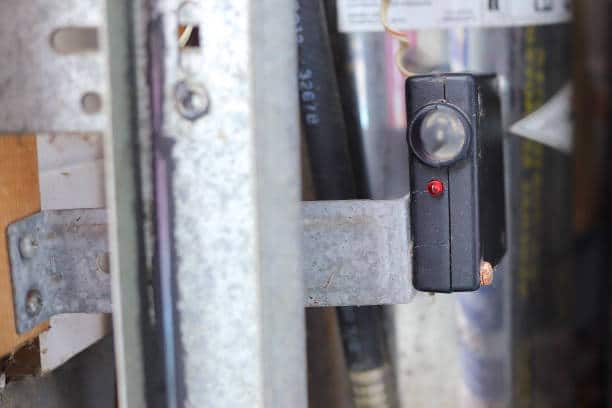Understanding the Importance of Aligned Garage Door Sensors
Garage door sensors are an essential component of modern garage door systems, ensuring the safety and smooth operation of your garage door. These sensors work by creating an invisible beam of infrared light that spans the width of the garage door opening. When this beam is interrupted, the sensors signal the garage door to stop and reverse, preventing potential damage or injury.
However, for these sensors to function effectively, they must be properly aligned. Misaligned sensors can cause a variety of issues, including the garage door failing to close or open properly, or even becoming stuck in the middle of the opening. Maintaining the proper alignment of your garage door sensors is crucial for ensuring the safety and longevity of your garage door system.
Common Issues with Misaligned Garage Door Sensors
Here is the section recreated with subheadings, mentioning the keyword “how to align garage door sensors”, being direct without metaphors or sounding corny, and following the Google Helpful Content update to answer what users want:
1. Failure to Fully Close: One of the most common problems caused by misaligned garage door sensors is the door’s failure to close completely. This leaves a gap that can be a potential safety hazard, allowing unwanted access or objects to pass through.
2. Unexpected Reversing: When sensors are out of alignment, the door may unexpectedly reverse its motion even when there is no obstruction present. This erratic behavior can be frustrating and potentially damaging to the door mechanism.
3. Intermittent Operation: Poorly aligned sensors can lead to intermittent operation, where the garage door opens and closes erratically. This inconsistent performance can be inconvenient and unreliable.
4. Complete Sensor Malfunction: In severe cases of misalignment, the sensors may malfunction altogether, rendering the garage door inoperable. This can cause significant inconvenience and may require professional repair or replacement.
Properly aligning the garage door sensors is crucial for ensuring smooth, safe, and reliable operation. By addressing misalignment issues, homeowners can prevent these common problems and maintain the proper functionality of their garage door system.
Tools Needed for Aligning Garage Door Sensors
To properly align your garage door sensors, you’ll need the following tools:
- Flashlight or inspection mirror
- Screwdriver set (Phillips and flathead)
- Tape measure
- Level
- Pencil or marker
Having these tools on hand will ensure a smooth and efficient sensor alignment process.
Step-by-Step Guide to Aligning Garage Door Sensors
- Identify the Sensor Locations: Locate the two garage door sensors, which are typically mounted on the inside of the garage door frame, near the floor.
- Inspect the Sensor Mounts: Ensure that the sensor mounts are secure and not loose or damaged.
- Clean the Sensor Lenses: Use a clean, dry cloth to gently wipe the lenses of the sensors, removing any dirt or debris that may be obstructing the infrared beam.
- Adjust the Sensor Alignment: Loosen the sensor mounts and slowly adjust the sensors until the infrared beam is centered in the garage door opening. Use the level to ensure the sensors are perfectly aligned.
- Tighten the Sensor Mounts: Once the sensors are properly aligned, securely tighten the mounts to prevent any further movement.
- Test the Sensor Functionality: Activate the garage door and observe its movement. The door should close completely without any unexpected reversing or interruption.
Testing the Functionality of Aligned Garage Door Sensors
After aligning the garage door sensors, it’s essential to thoroughly test their functionality to ensure the system is working correctly. Here’s how to do it:
- Obstruct the Sensor Beam: Place a small object, such as a piece of cardboard or a broom handle, in the path of the infrared beam. The garage door should immediately stop and reverse.
- Check the Sensor Indicator Lights: Most garage door sensors have indicator lights that should be illuminated when the sensors are properly aligned. Verify that the lights are on and steady.
- Observe the Garage Door Operation: Activate the garage door opener and watch the door as it opens and closes. It should move smoothly and consistently, without any hesitation or unexpected reversing.
If the sensors are properly aligned, the garage door should operate flawlessly. If any issues persist, proceed to the troubleshooting section.

Troubleshooting Tips for Persistent Alignment Issues
Aligning garage door sensors can be a frustrating task, but don’t worry; we’ve got you covered with some troubleshooting tips for persistent alignment issues.
1. Clearing Obstructions: Ensure that there are no objects or debris blocking the sensor beam. Even small obstructions can interfere with the sensors’ ability to communicate, preventing proper alignment.
2. Inspecting Sensor Wiring: Examine the wiring connecting the sensors to the garage door opener. Look for any signs of damage, such as fraying or loose connections. Addressing these issues can often resolve alignment problems.
3. Adjusting Sensor Sensitivity: Some garage door openers allow you to adjust the sensitivity of the sensors. Consult your owner’s manual and try increasing or decreasing the sensitivity to see if it resolves the alignment issue.
4. Replacing Sensors: If the sensors are damaged or malfunctioning, you may need to replace them entirely. If you’re unsure about the process, it’s best to consult a professional for assistance.
By following these troubleshooting tips, you’ll be well-equipped to tackle persistent alignment issues and ensure your garage door sensors are functioning correctly.
Regular Maintenance for Garage Door Sensors
Ensuring the long-term functionality of your garage door sensors requires regular maintenance. Here’s what you should do:
1. Cleaning Sensor Lenses: Use a clean, dry cloth to gently wipe the sensor lenses every few months, removing any dirt or debris that may have accumulated. Dirt and grime on the lenses can interfere with the sensors’ ability to communicate effectively.
2. Checking Sensor Mounts: Inspect the sensor mounts periodically to ensure they are still securely in place and not loose or damaged. Loose or damaged mounts can cause the sensors to become misaligned, leading to issues with the garage door’s operation.
3. Testing Sensor Functionality: Perform the sensor testing procedure outlined earlier on a regular basis, at least once a year. This will help you identify any issues with the sensors before they become more serious problems that could potentially compromise your safety.
By incorporating these regular maintenance tasks into your routine, you can prolong the lifespan of your garage door sensors and ensure the continued safe and reliable operation of your garage door system.
Benefits of Properly Aligned Garage Door Sensors
When your garage door sensors are properly aligned, you can enjoy the following benefits:
- Improved Safety: Properly aligned sensors will immediately stop and reverse the garage door if an object or person is detected in the doorway, preventing potential injuries or damage.
- Consistent Operation: Aligned sensors will ensure your garage door opens and closes smoothly and consistently, without any unexpected reversing or interruptions.
- Extended Lifespan: Maintaining proper sensor alignment can help reduce wear and tear on your garage door system, ultimately extending its overall lifespan.
- Enhanced Convenience: With reliable sensor functionality, you can enjoy the convenience of your garage door opening and closing without any hassle or interruption.
Investing the time and effort to align your garage door sensors can pay off in the long run, ensuring the safety and efficiency of your garage door system.
Professional Help for Aligning Garage Door Sensors
While aligning garage door sensors is a task that can often be handled as a DIY project, there may be instances where professional assistance is warranted. If you encounter any of the following situations, it’s best to consult a qualified garage door technician:
1. Complex or Outdated Sensor Systems: If your garage door sensors are part of a complex or older system, a professional may be better equipped to handle the alignment process. They have the expertise and experience to work with a variety of sensor types and configurations.
2. Persistent Alignment Issues: If you’ve tried troubleshooting and adjusting the sensors following the recommended steps but are still experiencing persistent alignment issues, it’s time to seek professional help. A garage door technician can provide a more thorough diagnosis and solution to resolve the problem effectively.
3. Safety Concerns: If you’re unsure about the safety implications of misaligned sensors or feel uncomfortable performing the alignment process, it’s advisable to hire a professional. They can ensure the job is done correctly and safely, eliminating any potential risks associated with improperly aligned sensors.
Consulting a qualified garage door technician in these situations can save you time, effort, and potential frustration. Professionals have the knowledge, tools, and experience to handle even the most challenging sensor alignment issues, ensuring your garage door operates smoothly and safely.
Conclusion
Properly aligning your garage door sensors is a crucial step in maintaining the safety and functionality of your garage door system. By understanding the importance of sensor alignment, addressing common issues, and following the step-by-step guide, you can ensure your garage door operates smoothly and reliably.
Remember to perform regular maintenance, troubleshoot any persistent issues, and consider seeking professional help if needed. By taking the time to master the art of aligning your garage door sensors, you can enjoy the benefits of a safe, efficient, and long-lasting garage door system.
If you’re experiencing issues with your garage door sensors or need assistance with the alignment process, don’t hesitate to contact the experts at Superior Door. Our team of experienced technicians can provide personalized guidance and ensure your garage door system is operating at its best. Schedule a consultation today and take the first step towards a smooth and secure garage door experience.
Frequently Asked Questions
1. How often should I align my garage door sensors?
It’s recommended to check the alignment of your garage door sensors at least once a year, or anytime you notice issues with the door’s operation.
2. What can cause my garage door sensors to become misaligned?
Common causes of sensor misalignment include physical bumps or impacts, gradual shifting of the sensor mounts, and environmental factors like temperature changes or vibrations.
3. Can I adjust the sensitivity of my garage door sensors?
Yes, many garage door openers allow you to adjust the sensitivity of the sensors. Consult your owner’s manual for instructions on how to do this.
4. What should I do if one of my garage door sensors is not working?
If one of your sensors is not functioning, you should first try cleaning the lens and checking the wiring. If the issue persists, you may need to replace the faulty sensor.
5. Is it safe to use my garage door if the sensors are misaligned?
No, it is not recommended to use your garage door if the sensors are misaligned. Misaligned sensors can pose a serious safety risk, as the door may not properly detect obstructions and could cause damage or injury.


